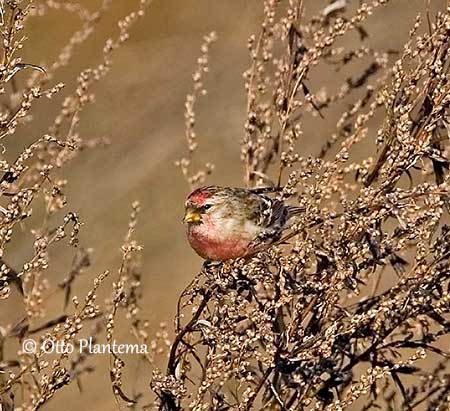
Fr: Sizerin flammé
Ang: Common redpoll
All: Taigabirkenzeisig
Esp: Pardillo Norteño
Ita: Organetto
Nd: Grote Barmsijs
Sd: Gråsiska
Photographers:
John Anderson
John Anderson Photo Galleries
Jean Michel Fenerole
Photos d’Oiseaux du monde
René Lortie
René Lortie photographe & Galeries d'oiseaux sur Pbase
Otto Plantema
Trips around the world
Ingo Waschkies
My bird pictures on Pbase
Text by Nicole Bouglouan
Sources:
HANDBOOK OF THE BIRDS OF THE WORLD Vol 15 by Josep del Hoyo-Andrew Elliot-David Christie - Lynx Edicions – ISBN: 9788496553682
THE COMPLETE BOOK OF BRITISH BIRDS – Written by “Royal Society for the Protection of Birds” experts - Préface de Magnus Magnusson - Michael Cady- Rob Hume Editors - ISBN: 0749509112
THE HANDBOOK OF BIRD IDENTIFICATION FOR EUROPE AND THE WESTERN PALEARCTIC by Mark Beaman, Steve Madge - C. Helm - ISBN: 0713639601
All About Birds (Cornell Lab of Ornithology)
Bird Web (Seattle Audubon Society)
What Bird-The ultimate Bird Guide (Mitchell Waite)
SORA Searchable Ornithological Research Archive (Blair O. Wolf)
THE WILSON BULLETIN - NESTING HABITS OF THE COMMON REDPOLL
BY LAWRENCE I. GRINNELL
Common Redpoll
Acanthis flammea
Passeriformes Order – Fringillidae Family
INTRODUCTION:
The Common Redpoll is a pretty songbird of the boreal forest of pines, spruces and larches. It ranges through northern Europe and Asia to northern North America, Greenland and Iceland, and moves southwards in late autumn, after breeding.
These tiny birds are very resistant to cold temperatures. Their movements depend on food availability, not on weather conditions. They feed mostly on seeds almost all the year, and eat insects during summer. They are always very active among the vegetation or on the ground.
The Common Redpoll has complex taxonomy with several subspecies related to each part of the range. This species, especially the race “A.f. cabaret” was introduced in New Zealand from Britain between 1862 and 1875. It is widespread throughout the South Island and occurs on many offshore islands.

DESCRIPTION OF THE BIRD:
Biometrics:
Length: 12,5-14 cm
Wingspan: 21-23 cm
Weight: 10-17 gr
The Common Redpoll adult male is a small grey to brownish-grey finch, with conical bill and slightly forked tail. The upperparts show extensive dark grey-brown streaking, with whitish fringes to mantle feathers and scapulars. The greyish-white rump is tinged pink, the uppertail-coverts are grey-brown with dark centres, and the tail is dark grey with narrow buffy-white edges. The upperwing is dark brown and shows a double pale wingbar formed by the white or whitish-buff tips of median and greater wing-coverts. The flight-feathers show narrow pale edges.
The underparts are pale greyish-white, but throat and breast are tinged pink. Flanks and sides of belly are streaked brownish. Belly and undertail-coverts are whiter, with broad tapering dark shaft streaks, sometimes absent.
On the head, lower forehead and lores to chin are black, whereas upper forehead and forecrown are deep red. Crown to nape are pale grey to greyish-buff with fine dark streaks. We can see a narrow, pale supercilium extending to rear of ear-coverts, and a thin, dark eye stripe. Cheeks and ear-coverts are pale grey-brown with buffish or pinkish wash on lower parts.
The short, conical bill is horn-coloured with dark tip, generally dull yellow or pale horn with darker culmen and tip. The eyes are dark brown. Legs and feet are blackish.
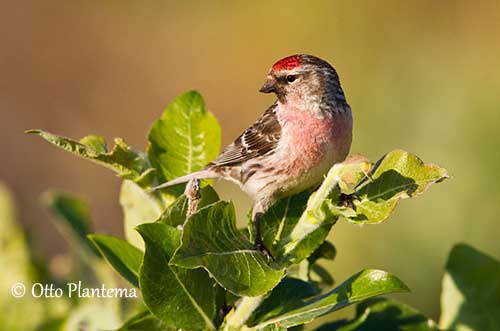
The Common Redpoll male adult in non-breeding plumage is paler and greyer on head and nape with pale neck sides. The upperparts are buffy-brown with paler centres of mantle and back and with brown streaks. The tail is dark grey with greyish-white fringes. The upperwing shows more pale tips to coverts, and broader pale grey fringes to flight-feathers.
On the underparts, throat and breast are white or greyish with brownish streaks, becoming pink in worn plumage. Flanks are tinged buff-brown.
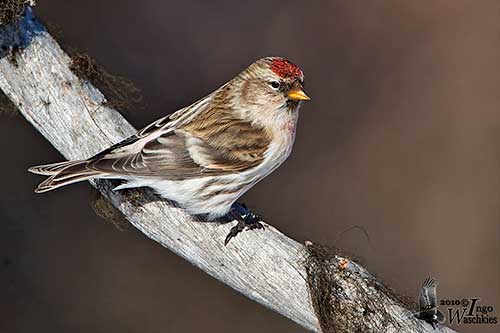
The adult female resembles male, but she lacks the pink on face, breast and rump, or this colour is greatly reduced. She has heavier streaking on back and rump. The underparts are buff in fresh plumage, or greyish-white in worn plumage, with dark streaks except on belly. The black chin patch is duller and more rounded than in male.
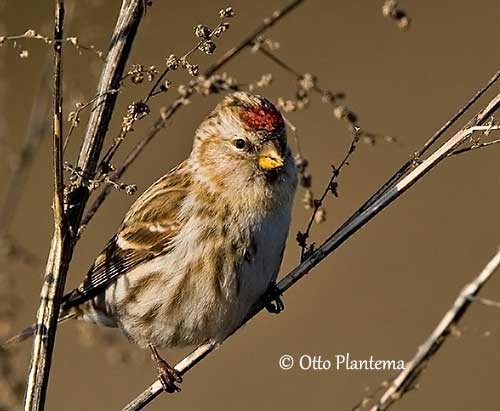
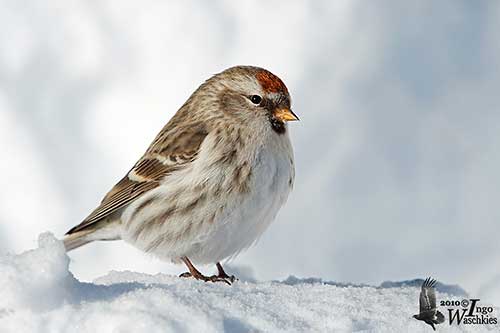
The juvenile resembles female but it is paler and lacks any red colour on crown and pink on plumage, with heavier streaking on the underparts.
The first winter has red, orange or yellowish patch on forehead, and it has more pink on cheek, uppertail-coverts and breast than juvenile.
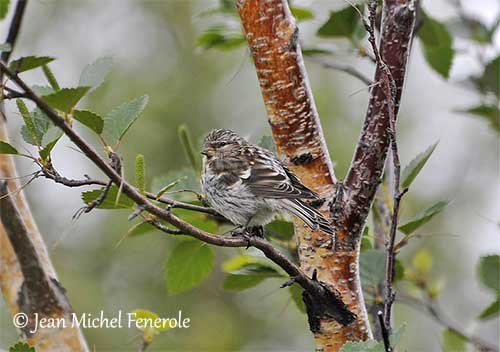
SUBSPECIES AND RANGE:
The Common Redpoll has very complex taxonomy varying according to the authors. In addition to the two usually recognized subspecies, the Lesser Redpoll (A. cabaret) is also considered a subspecies on this page.
A.f. flammea or Mealy Redpoll (described above) breeds from Iceland and Scandinavia, E across N and C Russia and Siberia to Kamchatka and Bering Sea, S to C Urals, Stanovoy Mts, Amurland and Sakhalin, and also in N North America from Alaska E to Newfoundland.
It winters S to NW and C Europe, C and E Asia S to Mongolia, NE China, Korea, Japan and also in N and C USA (S to Oregon, Colorado and South Carolina).
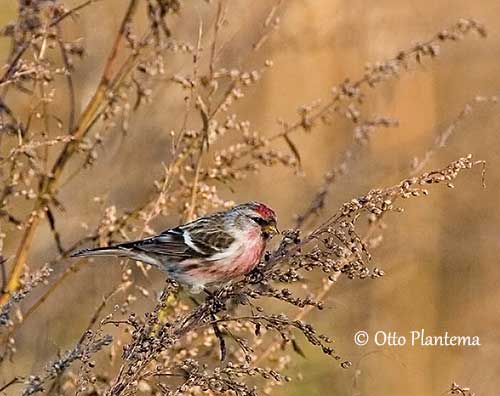
A.f. rostrata or Greenland Redpoll breeds in NE Canada, W and SE Greenland and Iceland. It winters in E Canada, NE USA, Iceland and NW British Islands.
This race is larger than nominate, with larger bill and longer wings. The upperparts are browner and heavily streaked, the rump may be whiter with dark streaks. Lores, chin and throat are more extensively black. Breast sides, flanks and undertail-coverts are heavily streaked dark brown.
In summer, the male has less extensive pink on breast, while rest of underparts are whitish. There are broad wingbars, mainly on greater coverts.
The Icelandic population is close to “rostrata” and sometimes treated as a full race (A.f. islandica), but differences are too slight to warrant separation. A minority of individuals are distinctly pale.
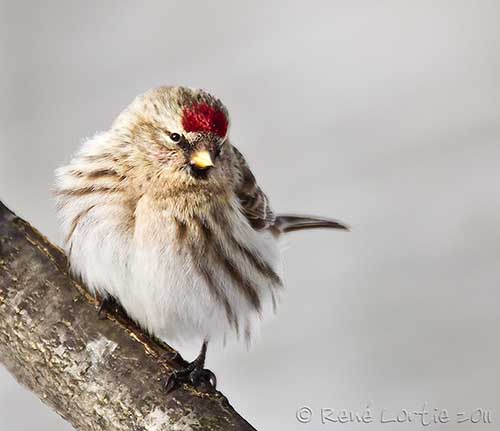
A.f. cabaret or Lesser Redpoll breeds in British Islands, SW Norway, S Sweden, Denmark and N and NE France, E to Belgium and Netherlands. It also occurs in N and C Germany, Alps from SE France to Austria, and Carpathians. It is widespread in NC and S Europe outside the breeding season. It was introduced in New Zealand where it is widespread throughout the South Island and occurs on many offshore islands.
This race is smaller and browner, with strong buff-brown tones to mantle and breast sides, contrasting with the white centre of the breast.
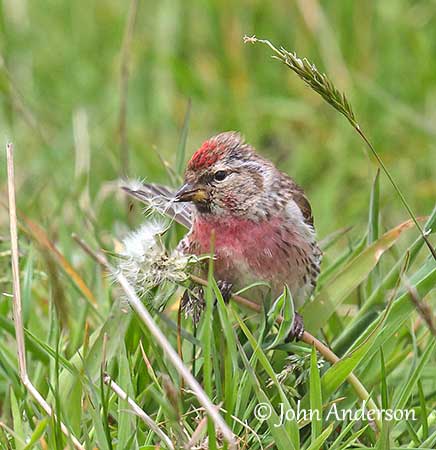
HABITAT:
The Common Redpoll breeds in dwarf birch and willow scrub in lowland treeless tundra and in open taiga of pine and spruce in the northern part of the range. But farther south, it breeds in wooded slopes and swampy areas, and riverine thickets with various tree species.
Outside breeding season, it is found in a variety of scrubby wooded habitats, especially with birches and alders by streams, and in brushy or weedy fields.
This species can be seen from sea-level up to more than 1000 metres of elevation (1100-1350m) and up to 1850-2100 metres in Altai where it breeds in alpine meadows.
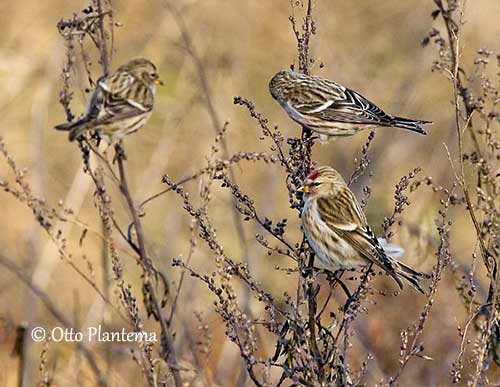
CALLS AND SONGS: SOUNDS BY XENO-CANTO
The Common Redpoll gives twitter call “djek-djek-djek”. Other calls include a ringing “tsooeet” rising at the end, and often accompanied by twittering. The alarm call is an explosive “chek” or “tek”.
The advertising song given during territorial behaviour is a series of “teu-teu-teu-teu” followed by dry or buzzy “trrrrrreeeee”. A shorter “tirr” or “serrrrr” is given in flight or from perch. During aggressive encounters, the male gives loud, harsh “chak”.
The race “rostrata” gives louder and harsher calls than nominate.
The race “cabaret” utters similar calls and songs that “flammea”.
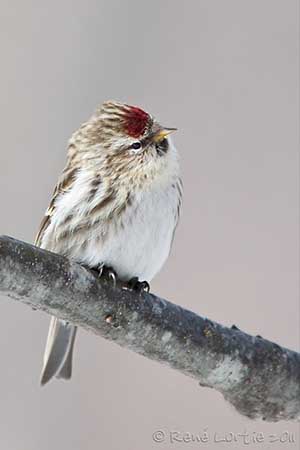
BEHAVIOUR IN THE WILD:
The Common Redpoll feeds mainly on seeds, buds and small invertebrates. Seeds and plant matter are consumed almost all year round. The diet includes catkins, seeds and buds of willows, alders and birches, seeds of small conifers and of numerous weeds and grasses. However, it feeds on insects during summer while breeding.
The Common Redpoll forages very actively in trees, low vegetation, shrubs and weeds and on the ground. In Alaska, it also forages in holes and under the snow. It feeds acrobatically, clinging to the vegetation and hanging upside-down on cones or catkins and outermost branches. It also perches on twigs and bent them to reach the seeds. It often feeds with flocks of Eurasian Siskins. It also frequents feeders.
The Common Redpoll has a peculiar morphological feature, a pouch within the throat, used for storing the food for up to several hours. This allows the bird to feed rapidly in the open in cold weather and then, it digests this food quietly in a sheltered place.
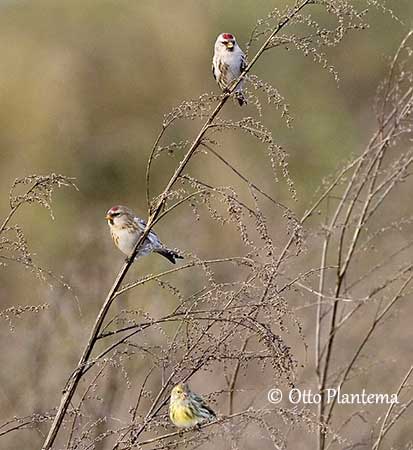
A.f. flammea
The Netherlands
With a female Eurasian Siskin at the bottom
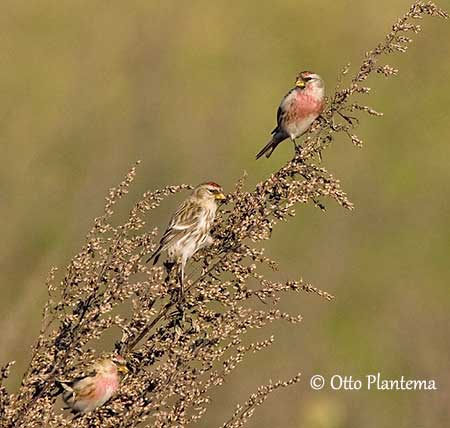
Outside breeding season, they usually forage in flocks. Males are dominant in winter flocks, but as the breeding period approaches, the roles are reversed and the female become dominant and often take the lead in courtship.
The Common Redpoll is usually monogamous, but the pair-bond lacks only a single season. The male performs aerial displays to attract a female, and courtship feeding is common. Aerial displays consist of flying in slow circles with deeply undulating flight while calling and singing, giving territorial song.
During aggressive encounters between rivals, the Common Redpoll fluffs its plumage. It faces its opponent and opens its bill while raising it to display the black chin patch.
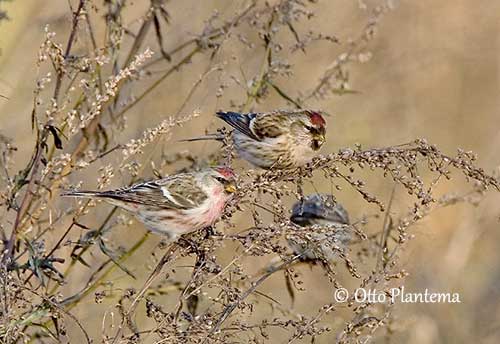
The Common Redpoll can be resident, migratory and irruptive. Most birds migrate after breeding to non-breeding grounds, with passage mostly between October and mid-November, but sometimes as soon as mid-September in irruption years. The movements vary every year depending on birch seed crop. Most movements are related to food supply, more than to cold weather. The return migration can be prolonged from mid-April to early June.
The race “rostrata” is a vagrant in Azores.
The race “cabaret” is both resident and migratory. The Alpine breeders are sedentary or may perform some altitudinal movements over short distances. Movements are related to birch seed crop. It is vagrant in Iceland.
During migrations, they may form small to large flocks, from up to 100 in “cabaret” to thousands in nominate race.
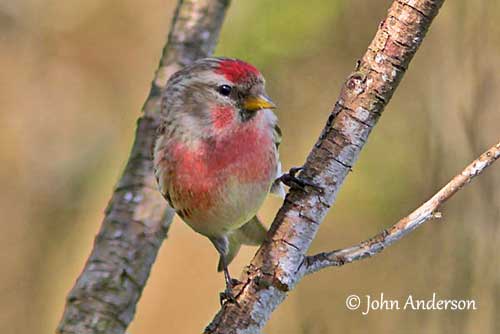
The Common Redpoll flies with undulating up-and-down pattern like numerous Fringillidae. It performs series of rapid wingbeats alternating with brief periods of wings pulled to sides.
REPRODUCTION OF THIS SPECIES:
The breeding season takes place from late April to August. The northernmost birds produce a single brood, whereas elsewhere, two broods can be laid, according to food availability.
The nest is usually placed up to 5 metres above the ground, in tree or shrub, often on branch close to the trunk or in canopy. In Scandinavia and N Russia, it may nest in vicinity of Fieldfares on more exposed branches. In northern tundra, it often nests in low bush, hummock or rocky ledge.
The nest is built by the female but the male sometimes collects material. The cup-shaped structure is made with grass, fine twigs and moss, and the cup is lined with feathers, plant down and animal hair. They may take material from an old nest, but do not reuse it.
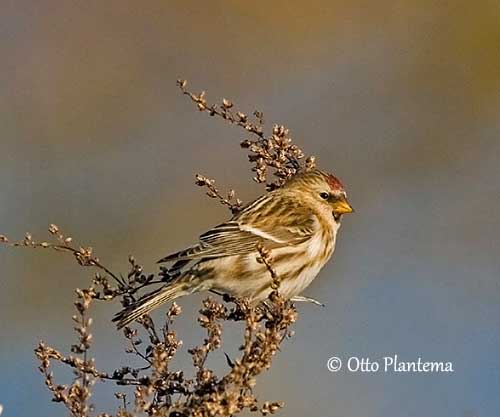
The female lays 4-6 pale green eggs with fine darker spots and lines. She incubates alone during 11-12 days, and she is fed on nest by the male. The downy chicks are fed mostly by the female, but sometimes by both parents. The male may bring food to the female and she feeds the chicks. The young leave the nest between 9 and 14 days after hatching, before to be able to fly. They become fully independent at 26 days old. A second nest may be started during the nesting period of the firs brood.
The main predators are Corvidae (magpies and jays) and Squirrels.
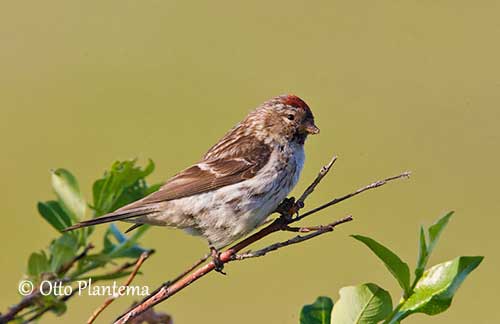
PROTECTION / THREATS / STATUS:
The Common Redpoll has large range in which it is common to locally common. The global breeding population is estimated by Partners in Flight at 160,000,000 (22% in USA and 17% in Canada). Estimated European population, 1,200,000/2,400,000 pairs, and between 10,000,000 and 100,000,000 pairs in Russia.
The race “rostrata” has extended its range N in Greenland in the 20th century.
The race “cabaret” has also extended its range to Belgium, Netherlands, Denmark and S Sweden, Czech Republic and N and C Germany. The populations are still increasing throughout the European range, but the British Islands breeding population has declined since 1970s, due to decrease of young coniferous woodlands availability. It has recently been moved to the Red List of Species of Conservation Concern. The species is common in New Zealand where it was introduced.
But currently, the Common Redpoll is evaluated as least Concern.
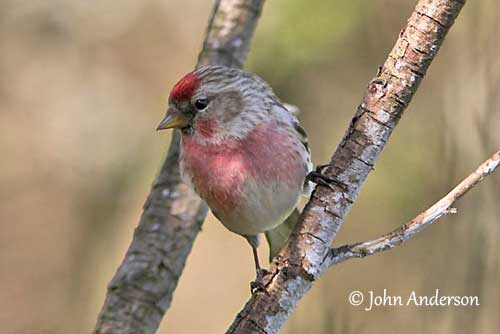
A.f. flammea
The Netherlands
A.f. flammea
The Netherlands
A.f. flammea
The Netherlands
A.f. flammea
The Netherlands
A.f. flammea
The Netherlands
A.f. flammea
The Netherlands
Pair
A.f. flammea
The Netherlands
A.f. flammea
Siberia
A.f. flammea
Siberia
A.f. cabaret
Scotland
A.f. cabaret
Scotland
A.f. cabaret
Bird seen on Chatham Islands (New Zealand)
A.f. flammea
Adult male in winter
A.f. flammea
Adult female in winter
Juvenile
Finland
A.f. rostrata
Quebec
A.f. rostrata
Québec